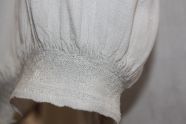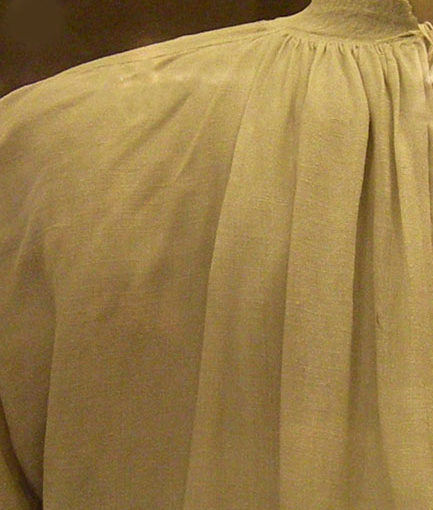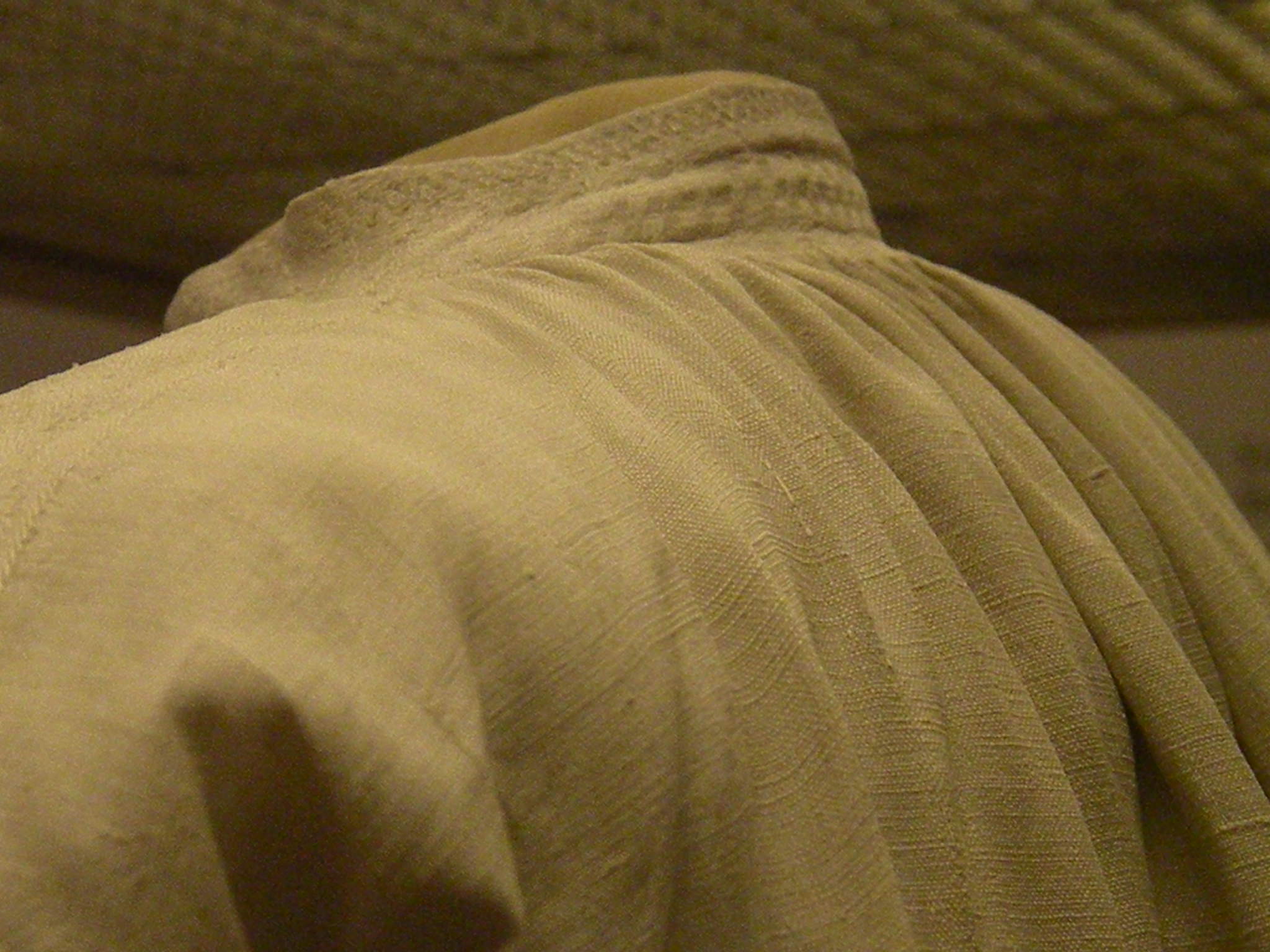Under the title "Stoff für Geschichte(n)" ("Fabric for History(s)"), the Fischer- und Webermuseum Steinhude, in cooperation with Leibniz Universität Hannover, presented an exhibition on a shirt woven in 1728 without a seam, which is still considered to be technically highly challenging to weave today. The exhibition is about the millennia-old phenomenon of seamlessness in the art of weaving, a textile ideal similar to squaring the circle or perpetual motion.
The idea of presenting this topic in a special exhibition arose in the context of a course at the university's history department and was developed by a project group of students with the help of museum director Sandra Kilb and lecturer Stephanie Kirsch. The close-knit structure of scientific research, pedagogical and professional expertise, and student initiative has resulted in a project that addresses both the historical context of seamlessness and the craftsmanship of seamless textiles.
In a lecture at Leibniz Universität Hannover, Eva Jordan-Fahrbach, textile conservator at the Herzog Anton Ulrich Museum in Braunschweig, presented the results of her three-month analysis of the seamless shirt before the exhibition opened: The seamless shirt was probably woven in 1728 by the young and ambitious 18-year-old weaver Johan Hendrick Bühmann from the weaving village of Steinhude. The motives are partly in the realm of historical circumstantial evidence. On the one hand, it was probably to prove himself worthy of the title of master - which, according to sources, had been denied before this exceptional piece. He had initially not been accepted into the Zuft founded shortly before in Steinhude. On the other hand, he apparently had his eye on the daughter of a local master weaver, whom he married after a long wait at the age of 36 - after the death of her father. The bride was 34 years old at the time and had apparently been waiting for him. In Steinhude, the story of the creation of this special shirt and weaving masterpiece is still alive today, as the son of the mayor of Steinhude reported during the lecture.
The seamless shirt of Steinhude was originally a double. The young weaver Heinrich Bühmann first wove a seamless copy. He then made a second seamless shirt for his sovereign, Albrecht Wolfgang Graf zu Schaumburg-Lippe. He is said to have bequeathed it to the King of Portugal through his noble connections. This second shirt is lost today.
The theme of seamlessness is already mentioned biblically. In the time of Heinrich Bühmann in Steinhude and even into the 19th century, other seamless shirts have survived. The Glasgow Museum owns a specimen made by a Scottish weaver. This shirt was made as a gift for King George IV in 1821.  This specimen is additionally equipped with woven-on ruffles at the breast slit. An illustration can be found in the book by Ursina Arn-Grischott "Doppelgewebe in der Handweberei". The museum gives silk as the material. It could also be the finest linen. In Scotland there are a total of four surviving seamless shirts, one of which is by Henry Inglis, another by Henry Meldrum, both of which are in the Dunfermline Museum, which is currently being rebuilt. In the inventory of the Focke Museum in Bremen is a seamless jacket from 1640.
This specimen is additionally equipped with woven-on ruffles at the breast slit. An illustration can be found in the book by Ursina Arn-Grischott "Doppelgewebe in der Handweberei". The museum gives silk as the material. It could also be the finest linen. In Scotland there are a total of four surviving seamless shirts, one of which is by Henry Inglis, another by Henry Meldrum, both of which are in the Dunfermline Museum, which is currently being rebuilt. In the inventory of the Focke Museum in Bremen is a seamless jacket from 1640.
Eva Jordan-Fahrbach has reconstructed the method of manufacture as follows: The key to the approach is the combination of Arachaic with modern weaving techniques. For example, the ancient technique of board or ribbon weaving has been alive in the Nordic culture from the Bronze and Iron Ages to the present day. The magnificent Germanic coats of splendor were made this way with a combination of ornamental bands by board weaving technique and transformation of the inlaid weft threads into warp threads in the - then common - weight loom. Details of this weaving technique are given by the master weaver Erika Arndt in her "Handbuch Weben". Here you can read about the reconstruction of the magnificent coat from the Hunteburg Moor near Oldenburg, which she rewove for the Landesmuseum in Hanover. Detailed execution of this technique can also be found in Stefan Mecheels/Hergert Vogler/Josef Kurz book "Kultur- & Industriegeschichte der Textilien". Similar to this technique - according to Eva Jordan-Fahrbach - the young weaver Heinrich Bühmann apparently took his seamless shirt off the loom several times and turned it 90 degrees each time. He let weft threads hang out of the fabric in order to then turn the fabric and put these threads back into the loom as warp threads and continue weaving. According to Eva Jordan-Fahrbach, Heinrich Bühmann began his woven fabrics at the neckband with a block damask of five-band warp and weft atlas. In antique fabrics, a block damask is called a sectional pattern in warp and weft counter weave, similar to a weave known today in mine cloths and also called peasant damask. Heinrich Bühmann made this block damask for the neckband in five-band warp and weft atlas and worked two buttonholes directly into it. From the weft threads hanging out of the cuff, including additional inserted threads for the necessary crimped fullness, he made the shoulder yokes decorated with bindings. The wefts again hanging out here he transformed into the warp threads of the front and back. Here, too, to get the necessary fullness, he inserted additional threads. From the first part of the torso he let the warp threads for the sleeves hang out. From the torso - into which he worked the chest slit - gussets were created in connection with the sleeves. The torso is made in double weave technique and finally as tubular weave and in the lowest part again woven with side slits. At the bottom, the shirt is provided with a solid edge by returning the warp threads one by one into the fabric and knotting them there in pairs on the inside. The sleeve cuffs also have slits and are again made in block damask, this time in sections with warp/weft twill 3/1, or 1/3.
 Throughout the shirt, Eva Jordan-Fahrbach analyzed different weaving techniques from twill and satin weaves to canvas and double weave to the ancient technique of taking out and repositioning the fabric in the loom. The thread density was extremely fine and high for a handwoven work: between 20 and 25 threads per centimeter in warp or weft, depending on the lot (densest in the gusset) per layer. In a double weave with two layers on top of each other, this meant a total density of 40 to 50 threads per centimeter. And this in the finest single-thread hand-spun linen. Above all, the challenge was also the conception of the fabric with these many successive techniques and sections, which required the fabric to be taken out of the weaving device several times in order to reposition the warp and weft thread systems and to continue weaving in a different direction. Details of the research report by Eva Jordan-Fahrbach with several illustrative photos from the analysis work are published in the journal "Spin off - Summer 2015".
Throughout the shirt, Eva Jordan-Fahrbach analyzed different weaving techniques from twill and satin weaves to canvas and double weave to the ancient technique of taking out and repositioning the fabric in the loom. The thread density was extremely fine and high for a handwoven work: between 20 and 25 threads per centimeter in warp or weft, depending on the lot (densest in the gusset) per layer. In a double weave with two layers on top of each other, this meant a total density of 40 to 50 threads per centimeter. And this in the finest single-thread hand-spun linen. Above all, the challenge was also the conception of the fabric with these many successive techniques and sections, which required the fabric to be taken out of the weaving device several times in order to reposition the warp and weft thread systems and to continue weaving in a different direction. Details of the research report by Eva Jordan-Fahrbach with several illustrative photos from the analysis work are published in the journal "Spin off - Summer 2015".





